
What's wrong with the investigation into the mysterious death of the hikers
KP correspondents found out why the death of the hikers in the Northern Urals, which happened more than half a century ago, became a hot topic in recent years
May 29, 2023. All rights reserved Komsomolskaya Pravda. Authors Nikolay Varsegov and Natalya Varsegova
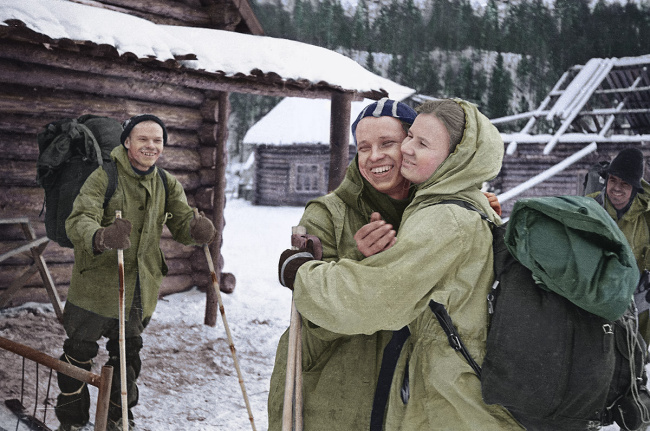
Igor Dyatlov (left) watches as Yuri Yudin (center) says goodbye to Lyuda Dubinina. Yuri left the route due to a suddenly sore leg. And survived. Photo from the materials of the case of the Dyatlov group, posted on the Dyatlov Pass website
The main secret of the Dyatlov Pass is revealed! And this secret, at least for people who do not follow the topic very carefully, is this: why did this tragedy, which happened more than 60 years ago, begin to concern everyone after so many years?
Recall that in the winter of 1959, nine hikers disappeared in the mountains of the Northern Urals: a fifth-year student of the Ural Polytechnic Institute (UPI), the head of the group Igor Dyatlov, as well as Yuri Krivonischenko, Yuri Doroshenko, Rustem Slobodin, Zinaida Kolmogorova, Lyudmila Dubinina, Aleksander Kolevatov, Nikolay Thibeaux-Brignolle and Semyon Zolotaryov. For 16 days, the participants of the trip had to ski in the north of the Sverdlovsk region for at least 300 km and climb two peaks of the Northern Urals. The trek belonged to the third (highest) category of difficulty.
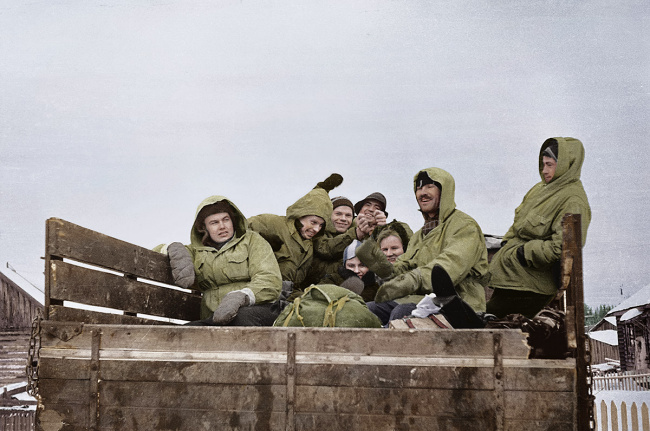
Hikers ride on a truck from Vizhay to 2nd Northern. Only Yuri Yudin (second from left) will return home. Photo from the materials of the case of the Dyatlov group, posted on the Dyatlov Pass website
A month later, rescuers found the empty tent of the group... And five frozen bodies within a radius of one and a half kilometers from it. The bodies of the rest were found only in May. The hikers were barely clad and not wearing shoes. Some had fatal injuries. According to investigators, the hikers died on the night of February 1-2. But it has not yet been figured out why the guys ran away from the tent into the bitter cold and to their death. Because of this understatement, dozens of different versions of the tragedy have appeared in our time: from an avalanche to an attack by Yeti, runaway prisoners and UFOs.
- 2 -
"This horror is unbearable"
Our country, and then the whole world, learned at least some reliable details about the death of the Dyatlov group only three decades after the tragedy. Before that, rumors were the most fabulous. The dead were often called geologists. The place of the tragedy was indicated from the Urals to Yakutia. Fictions were united with reality only by such details as a cut tent and dead bodies, but in very different quantities. It was necessarily said that the faces of the dead were contorted with horror. The militiaman, who first came across the dead, allegedly also died of fear. And in one geologist's pocket - again, according to idle rumors - they found a note "this horror is unbearable". The press, of course, did not write anything about it.
In the Urals, the rumors were a little different. They talked about skiers who cut their tent and jumped out as a result of testing a secret weapon. And in one case, all of them were hit by the weapons. In another case, they were allegedly killed by Chekists as dangerous witnesses to the tests.
The case file on the death of the Dyatlov group was kept under lock and key in the prosecutor's office of the Sverdlovsk region. A quarter of a century later, in 1974, it was transferred to the state archive.
Who had access to the case
But how did this high-profile case got to the public? This "secret of the pass" was discussed in Yekaterinburg at the IV All-Russian Conference dedicated to the mysterious death of the hikers. Correspondents of KP also took part in the conference.
The earliest memories of seeing the case by outsiders (not archivists) are associated with 1984. Vladislav Karelin, a participant in the search for the Dyatlov group, remembers:
- Opposite the building of the institute where I worked, there was a factory. The tourist section was actively functioning at the plant, headed by Leonid Skripov. Once, at a meeting, he asked me: "Do you want to see the criminal case on the death of the Dyatlov group?" I said yes, of course. The next morning I received the package with the condition to hold it only for one day. My work day was busy. Therefore, I was able to leaf through the volume of the case only in the evening at home. I flipped through the pages all night, until five o'clock in the morning. I made notes that I still have to this day. And in the morning I returned the volume to Leonid. I asked him: "How did this case come to you?" In response, he said that either his relative or a good friend works in the prosecutor's office. And since the classified stamp was removed from the case, the opportunity to get acquainted with it presented itself.
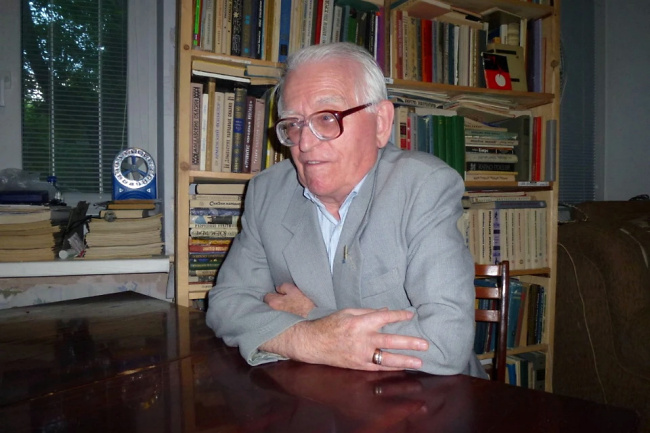
Searcher Vladislav Karelin read the criminal case back in 1984. Photo: Nikolay Varsegov
In the same 1984, student trainees of the Faculty of History of the UPI came across the criminal case in the State Archives of the Sverdlovsk Region (ГАСО). They told their friends about it. The case is small. The seal of secrecy has been removed. Rumors spread around the city - there are all sorts of examinations in the case, but there are no conclusions about the death of the guys. And then there are creepy photographs of corpses.
Around the same 1984, the case was read by the hiker Vladimir Ryabkov.
- I don't remember how it came to me, - said Ryabkov (hereinafter, all direct speeches are from the Yekaterinburg conference). - But I opened it and could not read it, it is written in too highly specialized language. I looked at the photos. And then things went hand in hand. And again it came across to me already in the zero years.
What a mess! The case went from hand to hand back in those strict Soviet times! It is possible that already then people began to disassemble it as a keepsake - pinch a page, steal a photograph.
- 3 -
First contact
In 1989, a group of students from UPI went on a winter trek to the pass. It was a route of the 2nd category of difficulty with the only purpose of understanding what happened to Igor Dyatlov and his comrades 30 years ago.
- The idea was to spend the night from February 1 to February 2 on the pass or under the pass, - said Elena Koskina, a participant in that hike. In recent years, she has been living abroad and, and recorded a video story about how it all began especially for the conference.
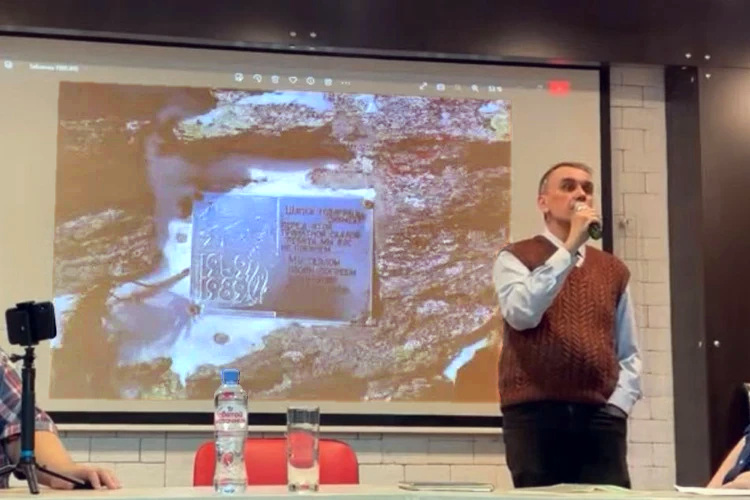
Aleksey Koskin told at the conference how it all began.
Spouses (now former) Elena and Aleksey Koskin became interested in this topic in 1989. Returning from the expedition, Elena firmly decided to find out the truth about the mysterious death of the hikers.
The girl was full of energy and enthusiasm. The most important thing was to read the criminal case in the archive.
- I turned to our history teachers for help, they helped to write out a pass to the archive, - Koskina recalls. - I was given two volumes. For a whole month I read this criminal case every day, copying by hand the most important documents, dates, versions. I became the first person who carefully worked with the case. I remember that I was scared to read all this and look at the photos. I gave my notes to my friends hikers. So information from the criminal case began to circulate.
Back then, the archive workers allowed the Koskins to take pictures of some of the case materials. These photos were printed in A4 format, then copies were made, which were distributed to journalists.
- After that, we began to meet with the relatives of the victims and with the searchers, - continued Elena Koskina. - The sister of Rustem Slobodin played a huge role, giving us a lot of photos. The brother of Lyuda Dubinina told everything he knew. We met with the radio operator of the search headquarters Egor Nevolin. But of particular interest was the medical examiner Boris Vozrozhdenniy, who dealt with the bodies of the Dyatlov group. In the criminal case were his date of birth, full name. I found the address through the address bureau. We came to him without a call. Boris Alekseevich received us, but behaved strangely. 30 years have passed. He remembered everything: the full names of the dead guys, their dates of birth, injuries, traumas, but he didn’t want to tell us anything. His wife, who ran to the kitchen from the room and exclaimed: "Why are you like that? You told me how it was!" In general, we did not receive any special information from the Vozrozhdenniy. And he advised us to find the former investigator Korotaev.
From the authors: Vladimir Korotaev shared a lot of information, but, unfortunately, not all of his stories can be trusted. Read more here.
Movie and a book
The first documentary film about the tragedy was filmed at the Ural Television Agency in 1997. Journalists Innokentiy Sheremet and Vlad Nekrasov became interested in the materials of the Koskins and created the series.
- We had copies of documents, interviews with searchers, there was no video filming of the pass itself, Vlad Nekrasov said. - The film didn't possess visual appeal, but it was a bomb in terms of content.
The series made a strong impression on the audience. For the first time, details of the tragedy were heard on television, copies of the materials of the criminal case were shown.
A couple of years later, the book "Dyatlov Pass" was published. Its author, Anna Matveeva, presented the whole story in an artistic manner based on real documents.
The Koskins involved journalists from the newspapers "Na Smena" and "Uralsky Rabochiy". Aleksey involved Moscow correspondents in this story. Notes about the Dyatlov group also appeared in foreign publications. It was important to make this story public in order to find those who know the truth about the causes of the tragedy.
- 4 -
Meeting with the investigator
Elena Koskina met the former forensic prosecutor Lev Ivanov in 1989-90. She traveled to Kustanai to hear it straight from the horse's mouth.
- He was glad that someone was interested in this case, - Elena recalls. "Unfortunately, he didn’t have much to say. The archive has not survived, except for photographs from the search. He remembered all the guys by their first and last names, some of the circumstances of the tragedy. And he did not hide his guilt for not being able to complete the task. Of course, I asked - what happened there? He didn't answer. And after some time he wrote in a letter that he would be sure until the end of his life that aliens were to blame for the deaths of the hiskres. And that he had these thoughts during the investigation, but he could not express them. They would have locked him for that.
Elena brought copies of documents from the criminal case to Ivanov. On their basis, in 1990, he wrote a long article in the local newspaper "Mystery of the Fireballs", in which he asked for forgiveness from the relatives of the victims.
By the way
Who stole the documents?
And now the most important thing. The criminal case is the main evidence of the tragedy. Every piece of paper, every word from the case matters. It is the reason why according to the rules of the archive, a certification inscription is drawn up for any cases, which indicates how many pages in total, when they were stitched, how they were numbered, etc. It is mandatory to have a seal and signature of a witness.
There is such an inscription in the criminal case of the Dyatlov group. It was compiled in 1996. It states that there are 400 sheets in the file, but two sheets, 370 and 375 - are missing.
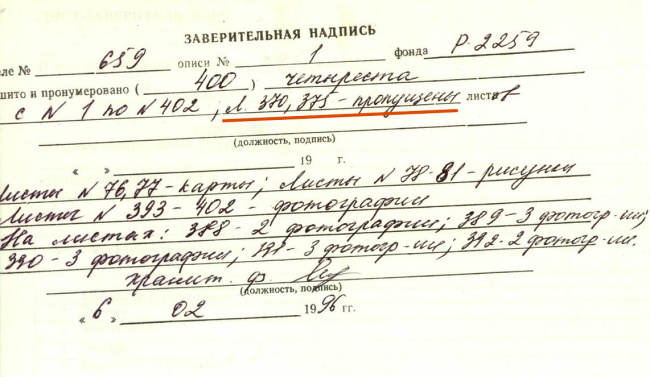
Certification inscription 1996 indicating the missing sheets
Missing sheets - a decision to conduct a physical and technical examination (radiological) and additional questions to the expert. We know what the documents are only because apparently archival workers took copies of the documents from the Internet and added them into the case file in the place of the missing originals. Where are the originals? Who and when made these copies and distributed them over the web?

Resolution for radiological testing (translation)
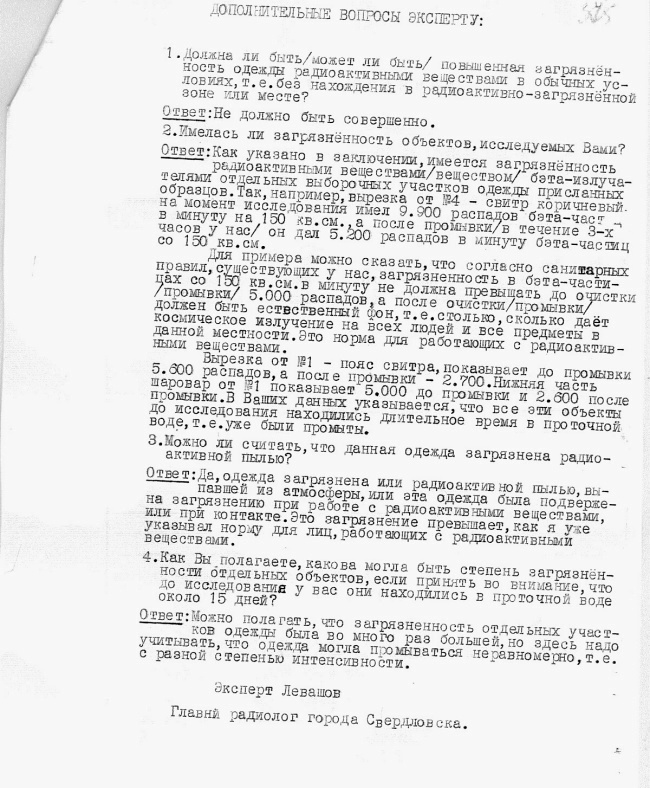
Questions to expert Levashov (translation)
- 5 -
Here they are, the consequences of passing the criminal case from hand to hand. It is possible that not only these sheets were missing. The big question is, whose hands did the photos go to? In the current version of the case, there are only two envelopes with photographs. And there were 12 of them! However, this is a completely different story. And we will definitely return to it.
From the authors
It is clear that the most interesting photographs have disappeared, if such a word can be used in relation to that tragedy. But what interest could be the decision to conduct a physical and technical examination (radiological) and additional questions to the expert, while in this case there are documents that are much more interesting. For example, the protocol of inspection of the scene.
In 2014, we met with the most important expert on this case, Evgeniy Okishev, who was the deputy head of the investigative department of the Sverdlovsk Region Prosecutor's Office and personally supervised the investigation. We have already written, but we will repeat, when we showed the case to Okishev in Chisinau in its current form, Evgeniy Fyodorovich, having carefully reviewed it, the next day literally told us that this was not the case with which he worked.
Okishev did not find in it, for example, evidence of many burnt matches under the cedar tree, where the bodies of Doroshenko and Krivonischenko were found. And this fact is amazing. After all, a month has passed since the tragedy, why were the matches not covered with snow, if those matches were burned by the hikers, and not someone else after? "We interrogated an employee of one of the northern camps," Evgeniy Fyodorovich later recalled. - He testified that he and his wife were returning home late at night from the cinema and saw strange flashes in the direction where the hikers died. In addition, there were also local residents who confirmed this phenomenon. We recorded all these testimonies in the protocol.
But even this very interesting testimony was not found in the case. So guess now, either enthusiasts took those protocols as a keepsake, or people in uniform seized them back in 1959, so as not to incline enthusiasts to undesirable guesses?
Apparently, in 1996, the criminal case of the Dyatlov group was renumbered and rebinded. Forensic expert Natalya Saharova told us about this. Why did they do this? Perhaps to hide the missing pages...









